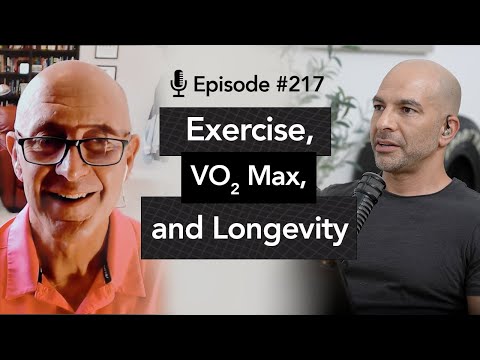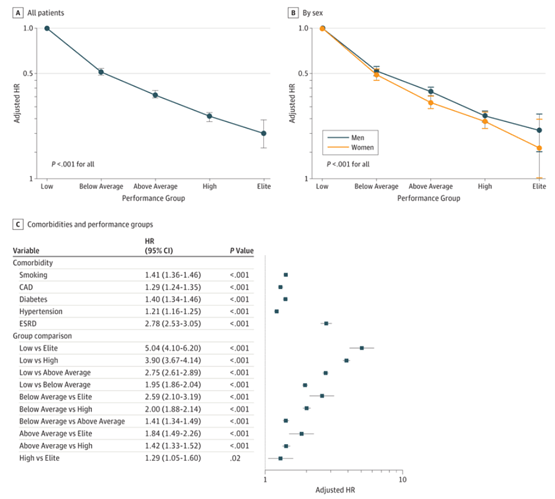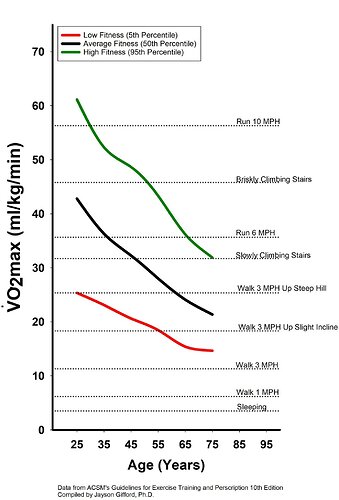I’m a moderate exerciser - 2 to 4 times a week for 1.5 hours or so each time, moderately strenuous (perhaps 40 or 50 METs as they describe it in the podcast. I’ve been thinking that was enough. But - I see the reductions of all-cause mortality as you continue to increase your fitness, and I think that I need to do much more. After listening to this podcast a few times, I figure I need to up my game… and work towards 100 METs per week.
Fitness reduces all-cause mortality and CVD
Peter Attia mentioned a paper in JAMA that he describes as by far the most compelling description of this phenomenon.
The figure below shows hazard ratios (HRs) for all-cause mortality of varying fitness compared to low performers
All-cause mortality was inversely proportional to cardiorespiratory fitness
Peter said that this paper is one he would consider one of the 10 most influential papers he’s read in terms of changing how he thinks about healthspan and lifespan
-
There are very few things in physiology where more is better
- Usually physiology behaves in J curves, plateaus, sigmoid curves, and things like that
- In this study people are grouped by fitness (see the figure below)
- Bottom 25th %
- 25-50%
- 50-75%
- 75-97.5%
- The elite fitness group was the top 2.5%
Full Paper:
Hazard ratios (HRs) for all-cause mortality compared with low performers. Image credit: JAMA Network Open 2018
As these people fitness increased, all-cause mortality just went lower and lower
Peter Attia notes:
“We often think about hazard ratios in risk reduction, but if you think about the risk increase. Compare people in the top 2.5% VO2 max to the bottom 25%, the hazard ratio moving in that direction is 5.04. See group comparison in the table above for Low vs. Elite”
This means there is a 5 fold increase in all-cause mortality between the fittest 2.5% and the least fit 25%
I also really liked the example of the Nordic cross-country skiers who were very active and fit into their 80s (doing 90km cross country ski trips). They were as fit and physically capable as many people 30 or 40 years younger. That is the type of fitness I’d like to have.
Examples where exercise preserves fitness in old age
- Studies of some Swedish cross-country skiers, men who were world and Olympic champions in the 40s and 50s
- They remained very active and were studied in their 80s, and their fitness levels were similar to what you would see in people in very early middle age
Mortality and cardiovascular morbidity among long-term endurance male cross country skiers followed for 28-30 years
Full Paper:
Mortality and cardiovascular morbidity among long-term endurance male cross country skiers followed for 28-30 years
http://sci-hub.wf/10.1111/j.1600-0838.2011.01307.x
Being unfit is an incredible risk factor ”‒ Mike Joyner
Jill Barnes and Mike wrote an editorial for the Mayo Clinic Proceedings 5-10 years ago where they said if people have 12-14 MET peak exercise capacity (with the exception of cancer screening), you could probably ignore everything else
It is no coincidence that the increase in chronic disease in people corresponds with the rapid decline in physical activity. The dramatic shift in lifestyle and behavior during the past 50 years is creating substantial challenges for the medical community to keep patients healthy. This issue of Mayo Clinic Proceedings includes a collection of articles that address declining physical activity in the general population and the resulting cardiovascular risk and mortality. Collectively, these articles highlight the importance of accurately quantifying physical activity in populations, 2, 3 determining the threshold metric for cardiovascular risk, 4, 5 and systematically delivering preventive recommendations to patients. 6 Three major points from these articles deserve emphasis: (1) fitness, and not just fatness, is important for stratifying cardiovascular risk; (2) simple physiologic measures, such as resting heart rate (RHR) and routine exercise testing, can be highly predictive of risk; and (3) physical activity should be recommended by all physicians, regardless of whether an institutional protocol for exercise prescription is yet in place.
How to figure out the MET equivalent for your workouts:


